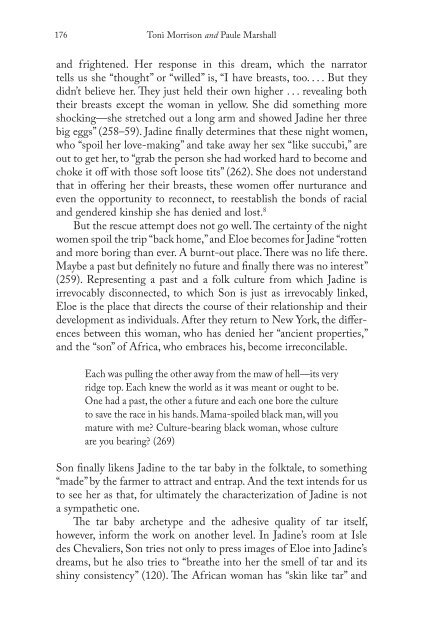Blooms Literary Themes - THE TRICKSTER.pdf - ymerleksi - home
Blooms Literary Themes - THE TRICKSTER.pdf - ymerleksi - home
Blooms Literary Themes - THE TRICKSTER.pdf - ymerleksi - home
Create successful ePaper yourself
Turn your PDF publications into a flip-book with our unique Google optimized e-Paper software.
176<br />
Toni Morrison and Paule Marshall<br />
and frightened. Her response in this dream, which the narrator<br />
tells us she “thought” or “willed” is, “I have breasts, too. . . . But they<br />
didn’t believe her. Th ey just held their own higher . . . revealing both<br />
their breasts except the woman in yellow. She did something more<br />
shocking—she stretched out a long arm and showed Jadine her three<br />
big eggs” (258–59). Jadine fi nally determines that these night women,<br />
who “spoil her love-making” and take away her sex “like succubi,” are<br />
out to get her, to “grab the person she had worked hard to become and<br />
choke it off with those soft loose tits” (262). She does not understand<br />
that in off ering her their breasts, these women off er nurturance and<br />
even the opportunity to reconnect, to reestablish the bonds of racial<br />
and gendered kinship she has denied and lost. 8<br />
But the rescue attempt does not go well. Th e certainty of the night<br />
women spoil the trip “back <strong>home</strong>,” and Eloe becomes for Jadine “rotten<br />
and more boring than ever. A burnt-out place. Th ere was no life there.<br />
Maybe a past but defi nitely no future and fi nally there was no interest”<br />
(259). Representing a past and a folk culture from which Jadine is<br />
irrevocably disconnected, to which Son is just as irrevocably linked,<br />
Eloe is the place that directs the course of their relationship and their<br />
development as individuals. After they return to New York, the diff erences<br />
between this woman, who has denied her “ancient properties,”<br />
and the “son” of Africa, who embraces his, become irreconcilable.<br />
Each was pulling the other away from the maw of hell—its very<br />
ridge top. Each knew the world as it was meant or ought to be.<br />
One had a past, the other a future and each one bore the culture<br />
to save the race in his hands. Mama-spoiled black man, will you<br />
mature with me? Culture-bearing black woman, whose culture<br />
are you bearing? (269)<br />
Son fi nally likens Jadine to the tar baby in the folktale, to something<br />
“made” by the farmer to attract and entrap. And the text intends for us<br />
to see her as that, for ultimately the characterization of Jadine is not<br />
a sympathetic one.<br />
Th e tar baby archetype and the adhesive quality of tar itself,<br />
however, inform the work on another level. In Jadine’s room at Isle<br />
des Chevaliers, Son tries not only to press images of Eloe into Jadine’s<br />
dreams, but he also tries to “breathe into her the smell of tar and its<br />
shiny consistency” (120). Th e African woman has “skin like tar” and

















